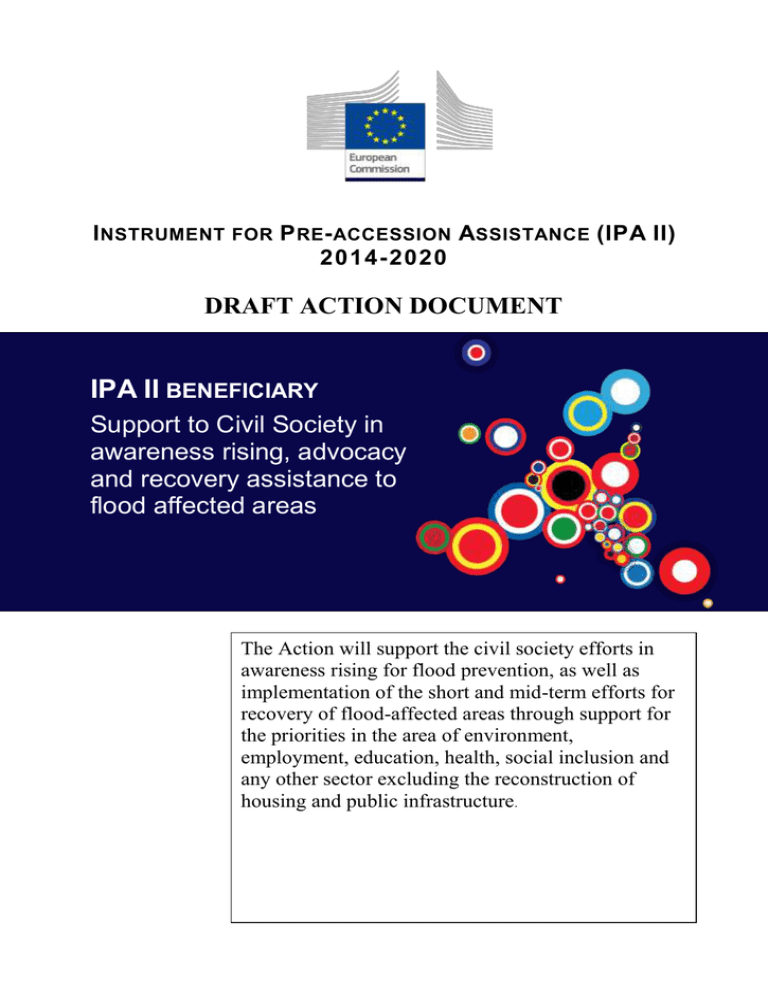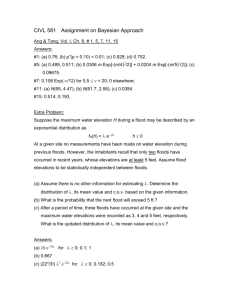the draft Action Document
advertisement

I NSTRUMENT FOR P RE - ACCESSION ASSISTANCE (IPA II) 2014-2020 DRAFT ACTION DOCUMENT IPA II BENEFICIARY Support to Civil Society in awareness rising, advocacy and recovery assistance to flood affected areas The Action will support the civil society efforts in awareness rising for flood prevention, as well as implementation of the short and mid-term efforts for recovery of flood-affected areas through support for the priorities in the area of environment, employment, education, health, social inclusion and any other sector excluding the reconstruction of housing and public infrastructure. 1. Rationale PROBLEM AND STAKEHOLDER ANALYSIS Bosnia and Herzegovina was hit by the heaviest rainfalls in May 2014 resulting in some of the worst floods on record. More than 50 people has been killed and tens of thousands people have been displaced and very high material damage occurred. The estimation is that at least 1 million persons have been affected in one way by the May floods. Water retention by soil and slopes was surpassed. These effects were aggravated by pre-existing environmental degradation associated with environmental degradation factors such as deforestation, intrusion in river beds and construction in hazardous risk exposed areas. The whole of the watershed leading to the river Sava was overwhelmed and peaked, generating flash floods and carrying debris downstream creating a path of destruction and desolation. The accumulated downstream flow of water, mud and debris caused widespread floods in the plain. As the river Sava peaked, drainage from the plain was made impossible causing the retention of water in lowlands for an extended period. Rainfall also caused more than 4,000 landslides in Bosnia and Herzegovina, prompting a landmine warning as 120,000 unexploded mines remain and could be unearthed by flood waters. A large number of municipalities immediately declared a state of emergency, with others following at a later stage. It is estimated that a total of 81 local governments suffered damages, losses, as well as social or environmental impacts of a varying degree. Around 90,000 persons were temporarily displaced from their homes and more than 40,000 took extended refuge in public or private shelters or moved in temporarily with relatives or friends. In sum, the total economic impact of the disaster (destruction or severe damage to property, infrastructure and goods as well the effects of destruction on livelihoods, incomes and production, among other factors) is estimated to have reached 3.98 Billion BAM. Most of it impacted the private sector; families, small, medium and large businesses, and agricultural producers, including an undefined number of vulnerable sectors of the population. The floods are estimated to have caused the equivalent of nearly 15 percent of GDP in damages (9.3 percent of GDP) and losses (5.6 percent) in 2014 in Bosnia and Herzegovina. This amounts to around 2.49 Billion BAM of damages and 1.49 Billion BAM of losses. The hardest hit economic sectors were agriculture, transport and productive activities. As a result, the economy of Bosnia and Herzegovina is expected to contract by 0.7 percent in 2014. The floods are expected to put further strain on public finances, raising the fiscal deficit from a baseline of 2 percent of GDP to 4.5 percent in 2014. A significant public sector financing gap of 1.7 percent of GDP has opened up, despite identified additional (to pre-floods needs) financing from domestic and international sources. The trade deficit is likely to come under pressure, widening to 34 percent of GDP in 2014 while the current account deficit is projected to increase from the baseline 7.8 to 9.7 percent of GDP in 2014. The damages are not uniform in character along different sectors and affected municipalities due to their different origin, i.e. landslides, floods or erosion, and intensity of the event. The Recovery Needs Assessment, conducted by domestic authorities with assistance provided by the European Union, the United Nations and the World Bank, found that floods affected nearly one million residents of Bosnia and Herzegovina. The Delegation of the European Union to Bosnia and Herzegovina launched in August 2014 the EU Floods Recovery Programme which is aligned with the Recovery Needs Assessment. The Programme is worth Euro 43.52 million, out of which EU finances EUR 42.24 million EUR, to help flood affected communities in Bosnia and Herzegovina. This ongoing Programme will contribute to flood recovery as immediate measure and it is implemented by the United Nations Development Programme in Bosnia and Herzegovina (UNDP), UNICEF and IOM, until October 2015. This assistance is focused on reconstruction of about 4,000 dwellings for approximately 14,000 people, restoration of critical local services and community infrastructure (including schools, health and social welfare centres, water and sanitation facilities, small community roads and bridges) in 50 localities, as well as providing support in retaining and creating up to 2,000 jobs in flood-affected areas. Selection of beneficiaries is based on the findings of the Recovery Needs Assessment and a public calls that are being announced, with a particular focus on the most vulnerable, such as the elderly, families with children and persons with disabilities, among others. 2 However the EU Floods Recovery Programme does not cover issues such as rising awareness, advocacy and recovery assistance to flood affected areas. Furthermore, the complex political system in the country reflects in many different approaches to management of rivers, lumbering, spatial planning and dealing with illegal contractions, landslides recovery and prevention, etc. In addition, almost no level of government has proper early warning system or strategies/plans on flood prevention. Lack of proper management of rivers, lumbering, construction activities, environment impact assessments, etc. contributed to devastating floods in May 2014. Therefore, the civic engagement as well as public awareness rising are needed in order to contribute to prevention of new floods. The second part of EU assistance from IPA II, amounting to 43 million EUR, will help BiH improve to its resilience to natural disasters, helping local NGOs with social development recovery assistance, and other necessary measures. This EU assistance will focus on the issues which are not covered through the EU Floods Recovery Programme, including rising public awareness on prevention of floods, local authorities’ accountability on prevention of floods and accountable management of water beds, assistance to recovery of jeopardised small independent businesses, smaller interventions in environment, employment, education, health sectors, etc. This assistance proposes 2 million EUR from IPA 2014 with aim to support the civil society efforts in awareness rising for flood prevention, as well as implementation of the short and mid-term efforts for recovery of flood-affected areas through support for the priorities in the area of environment, employment, education, health, social inclusion and any other sector excluding the reconstruction of housing and public infrastructure. The main purpose of this intervention is to contract grass roots local and international civil society organisations operating in BiH to implement of this assistance. This Action is supposed to provide good visibility of the European Union in the most flood-affected areas in Bosnia and Herzegovina, but also to ensure proper civic engagement in advocacy for future prevention of floods (for instance, issue of inappropriate maintenance of systems for water drainage channels or environment management, etc). In addition, this intervention is also expected to “seed” the civil society-government-citizens partnership in order to have the local communities working in integrative manner in the flood recovery process. In order to ensure proper coverage of the most flood-affected areas in BiH it is proposed to divide these areas into 9 geographical lots containing, in total, 41 municipalities as elaborated below: Indicative allocation of funds by lot/geographical distribution: Lot 1: Doboj region: (Doboj-Jug, Doboj-Istok, Usora, Modriča) Lot 2: Bijeljina region: (Lopare, Šekovići, Sapna, Teočak) Lot 3: B. Šamac/Domaljevac region: (Vukosavlje) Lot 4: Tuzla region: (Lukavac, Srebrenik, Petrovo, Gračanica, Kalesija) Lot 5: Zenica region: (Žepče, Maglaj, Zavidovići) Lot 6: Prijedor region: (Banja Luka, Čelinac, Sanski Most, Oštra Luka) Lot 7: Derventa region: (Laktaši, Srbac, Bosanski/Novi Grad) Lot 8: Brčko region (Orašje, Donji Žabar,Odžak) Lot 9: Kladanj region (Olovo, Živinice, Bratunac, Milići). Foreseen minimum and maximum thresholds for these grants are between 100,000 and 200,000 EUR with implementation period between 6 and 12 months. If the allocation indicated for a specific lot cannot be used due to insufficient quality or number of proposals received, the remaining funds will be reallocated to another lot. In order to enable faster contracting procedure there will be a request for derogation sent for reduction of period for application for open procedures from 90 down to 45 days. The evaluation can be finalised by the end of the year, and contracting can be done in 2015 as soon as the Framework Agreement for IPA 2 will be signed and ratified. 3 OTHER FINANCIAL ASSISTANCE In addition to the EU Floods Recovery Programme, 810,475,743 EUR have been pledged at the Donors’ Conference in Brussels in July 2014 for Bosnia and Herzegovina. Out of this amount 670,700,000 EUR will be implemented in the form of loans and 139,775,743 EUR in the form of grants. 4 2. INTERVENTION LOGIC LOGICAL FRAMEWORK MATRIX OVERALL OBJECTIVE Support to civil society organisations in recovery of flood-affected local communities in Bosnia and Herzegovina. SPECIFIC OBJECTIVE; To contribute to the implementation of the short and mid-term efforts for recovery of flood-affected areas through support for the priorities in the area of environment, employment, education, health, social inclusion and any other sector excluding the reconstruction of housing and public infrastructure. RESULTS 5 CSOs raise public awareness on a need for liable management of water beds, drainage systems, lumbering, as well as on risks of irresponsible spatial planning which may affect drainage of rain falls through public awareness and advocacy activities. CSOs assist targeted municipalities to develop flood prevention and monitoring plans as well as early warning systems. CSOs assist affected small independent businesses to recover in flood affected areas. CSOs assist the flood affected families in economic recovery. CSOs assist in environmental recovery in flood affected areas. OBJECTIVELY VERIFIABLE INDICATORS (*) SOURCES OF VERIFICATION Quality assessment of CS intervention in social-economic recovery in BiH in the flood affected areas. Reports, meetings, visits, monitoring missions OBJECTIVELY VERIFIABLE INDICATORS (*): Number of interventions by CSOs in achieving short and medium objectives for assistance to recovery of flood affected areas. SOURCES OF VERIFICATION OBJECTIVELY VERIFIABLE INDICATORS (*) Number of CSOs interventions in advocacy and awareness rising for flood prevention. Number of flood prevention actions including early warning systems. Number of assisted institutions in the area of education. Number of CSOs interventions provided to economic recovery of floods affected families. Number of CSOs interventions to recovery of flood-affected small independent businesses. Number of CSOs interventions SOURCES OF VERIFICATION Reports, meetings, visits, monitoring missions ASSUMPTIONS CSOs keen to assist in recovery of floods affected areas. Local authorities responsive to initiatives for future flood prevention. Reports, meetings, visits, monitoring missions ASSUMPTIONS Affected municipalities will be very much interested not only in ensuring assistance for socioeconomic recovery but also assistance in prevention of future floods and development of early warning systems. in environmental interventions. Number of interventions in the area of social inclusion. ACTIVITIES MEANS OVERALL COST Activities to achieve the identified results: Grant scheme with 10-14 contracts EUR 2 million - - 6 CSOs provide assistance in education, health, social inclusion in flood affected areas. CSOs in BiH identifying the needs for flood affected municipalities in terms of awareness rising and advocacy for future flood prevention as well as for recovery assistance in the targeted municipalities in socio economic areas (economic recovery, cultural recovery, prevention of diseases caused by floods, environmental interventions). Selection of grant beneficiaries through a Call for proposals. Implementation of awarded actions for flood recovery in the targeted municipalities. Provision of grants to third parties (where applicable) Monitoring, evaluation of the activities and, if necessary, advisory activities performed by the EUD. ASSUMPTIONS The whole amount will be utilised. Certain cofinancing can be expected from CSOs but not possible to forecast. ADDITIONAL DESCRIPTION The complex political system of the country reflects in many different approaches to management of rivers, lumbering, spatial planning and dealing with illegal contractions, landslides recovery and prevention, etc. In addition, almost no level of government has proper early warning system or strategies/plans on flood prevention. Lack of proper management of rivers, lumbering, construction activities, environment impact assessments, etc. contributed to devastating floods in May 2014. Therefore, civic engagement as well as public awareness rising are needed in order to contribute to prevention of new floods. In addition, the main focus of this intervention is to ensure appropriate visibility of the EU assistance to flood affected areas, but equally important, rise public debates and advocacy activities for prevention of similar floods in the future. For example, in some municipalities floods occur almost on annual basis due to the fact that local authorities are dealing mainly with the consequences of the floods not the causes. In addition, this intervention is also supposed to seed more regular civil society-local governments-public cooperation in order to ensure better management of local resources which will reduce the risk of floods in the future. This intervention is accompanied with small assistance, where necessary, in the areas of environment, education, employment, social inclusion. The whole Action will be closely coordinated with the EU Floods Recovery Programme in order to avoid overlapping but also to ensure synergy and maximisation of the impact of the EU assistance to flood affected areas. Re-granting will be possibly used. The duration of the intervention will be up to 12 months. 5. CROSS-CUTTING ISSUES ENVIRONMENT AND CLIMATE CHANGE (AND IF RELEVANT DISASTER RESILIENCE) Given its nature, the design of the Action does not include a specific environmental dimension. However, environmental consideration will be integrated into the Action since the whole purpose of the Action is to increase public awareness and conduct public debates on prevention of floods in the future (which cause mainly socio-economic problems) accompanied with minor assistance to flood affected locations in areas of environment, employment, education, social inclusion, etc. Therefore, all these activities will have an impact on environment (more accountable lumbering, planting of new trees, maintenance of drainage channels and river beds, etc). It is envisaged that continued activities and development in this area towards influencing the municipal governments to deal with the country's very real environmental problems would be covered by the project. Local authorities have an important role to play in environmental protection and civil society groups have been active in co-operating at local level in order to bring about improved practices. It is anticipated that this project would encourage and "systematize" this development. 7 ENGAGEMENT WITH CIVIL SOCIETY (AND IF RELEVANT OTHER NON-STATE STAKEHOLDERS) The Action envisaged the engagement of civil society organisation in implementation of the Action objectives. In addition, engagement of entities’ association of cities and municipalities is also foreseen in order to ensure share of best practices, exchange of practices, views, opinions, etc. EQUAL OPPORTUNITIES AND GENDER MAINSTREAMING Great challenges remain in Bosnia and Herzegovina to achieve gender equality and to allow equal opportunities for all. In the Terms of Reference it will be requested that successful candidate use gender-sensitive methodologies, closely monitor gender equality and minorities' rights and make sure that they are addressed properly. MINORITIES AND VULNERABLE GROUPS As regards international human rights instruments, Bosnia and Herzegovina has ratified all major UN and international human rights conventions. The principles of the European Convention on Human Rights are entrenched in the Constitution of Bosnia and Herzegovina, which also guarantees the supremacy of this Convention over national legislation. However, the Constitution fails to guarantee full access to fundamental human rights to so-called "nonconstituent peoples" in BiH. The judgment of the European Court of Human Rights in the Sejdic and Finci case has yet to be addressed, which relates to some major constitutional amendments. The Action will seek to mainstream addressing this issue as a key obstacle in the BiH EU integration process. In addition to constitutionally inherent political discrimination, Roma minority remains to live in extremely vulnerable conditions regarding health, employment and education. The very slow progress in this area will be also addressed by the Action. 6. SUSTAINABILITY In order to achieve sustainability beyond the implementation period, the design of the assistance takes account of the following: Financial assistance will be delivered in appropriate funding instrument in order to respond to different needs in flood affected areas. This will be done in a flexible, transparent, cost-effective and results focused manner; It will be requested that each grant application achieves flood prevention document plan which is expected to become an official document of each targeted local community (municipality). The focus of the assistance is on the analysis of what led to the extreme floods in May 2014, how to prevent them in the future including production of flood prevention plans. All these will be accompanied with the assistance in the areas of education, health, employment, social inclusion etc. Development of strategic documents for the flood affected municipalities is expected to be achieved through joint efforts of local governments and civil society. The Action will seek to have its outcomes enacted in relevant local legislation wherever possible with ensured financial resources and implementation mechanisms. 7. COMMUNICATION AND VISIBILITY Communication and visibility will be given high importance during the implementation of the Action. The Action will develop communication messages and tools adapted to these different audiences. They will be detailed in the Communication and Visibility Plan to be 8 drafted at the beginning of the Action. All necessary measures will be taken to publicise the fact that the Action has received funding from the EU. The Action will put particular emphasis on the dissemination of best-practices and exchange of information in order to increase the impact of results and bring a multiplier effect to other parts of the country. 9 10







